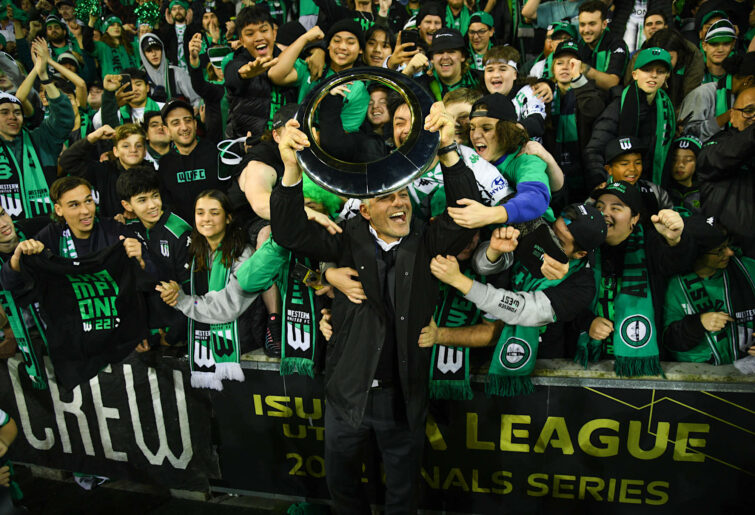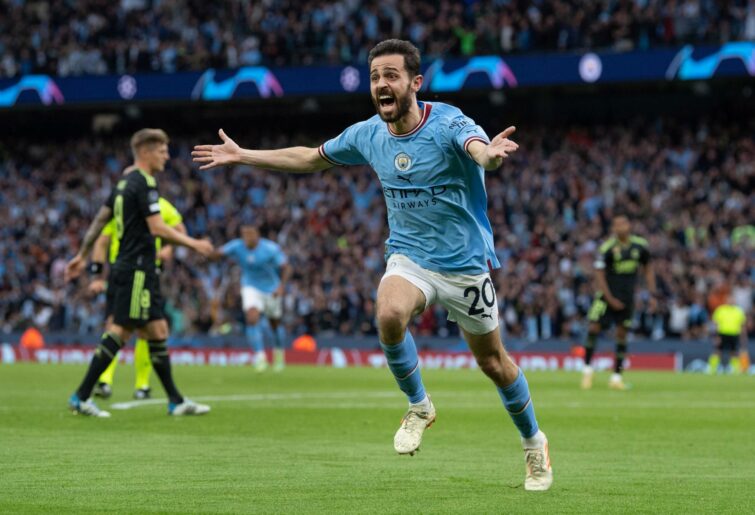In most parts of the world of football, there has never been a level playing field purposefully designed to make the competition as even as possible. The model of draft picks simply doesn’t exist.
Financially, the onus is on the club owners and the overall organisations to ensure it possesses sufficient finances to keep their teams alive, or else, risk the possibility of potential relegations and insolvency.
In Australia, however, they have never been part of that majority. Instead, the salary cap plays an integral part in the A-League’s quest for a balanced competition where the bigger clubs are not able to spend substantially more than those who cannot afford it.
That strategy has paid dividends, evident through eight out of the current 12 teams having won at least one Grand Final. Australians love an underdog story and are brought up in a culture that involves a different written narrative each season.

Western United. (Photo by Vince Caligiuri/Getty Images)
Going back to the point on financial responsibility, rich holding companies have heavily invested in European football to the point where the money involved has become utterly ridiculous. Financial Fair Play – the closest regulation to a salary cap – has failed to control large amounts of spending power.
Over a decade ago, City Football Group (CFG) purchased English club Manchester City with a vision in mind to dominate both the domestic and European fronts.
Over time, over ₤1 billion spent in transfer fees and attracting the best players and coaches in the world have led to City’s 17 trophies, which manager Pep Guardiola should add another to help the club claim their seventh Premier League title since the takeover.
Back in January 2014, Melbourne City was purchased by the same group of investors, identifying some potential in a club barely four years old at the time. Since then, the club has grown leaps and bounds, with an A-League championship, three premierships and an Australia Cup to their name.
During the week, Manchester City dismantled Real Madrid 4-0 to book their passage into the UEFA Champions League Final, as Melbourne City won by the same scoreline against Sydney FC to reach a fourth consecutive Grand Final.
Both clubs have been head and shoulders above the rest of their respective competition with the football produced on the pitch. No one comes close. The blue half of Manchester’s soon-to-be seven domestic league titles and the blue half of Melbourne’s three consecutive premierships and four straight Grand Finals provide clear proof.
The proposal of a European Super League put together by the top clubs from the best leagues was mainly influenced by the unstoppable dominance of the likes of Man City and Paris Saint-Germain. Especially with the pandemic taking a massive toll, how could the Super League’s three main instigators in Real Madrid, Barcelona, and Juventus possibly compete at the very top with the amount of debt owed?
Will they ever return to their glory days?
Madrid completed 13 passes in the first 15 minutes with 20 per cent possession in the first half alone on Thursday. Why? Because of the quality of depth helped by the endless streaming of financial resources.
Now, Guardiola’s men will come up against Italian giants Inter Milan in the final where most people are arguing that it will be one of the most one-sided finals in recent history. Inter, to their credit, have completed some smart transfer business with their hands tied due to financial issues, but again, how can they possibly compete?

(Photo by Mattia Ozbot – Inter/Inter via Getty Images)
As mentioned before, the implementation of the salary cap in Australia helps steer clear of inflation spending demonstrated in Europe and parts of Asia, such as China in particular. For now, that’s the most sensible approach for a league only 18 years old with its clubs still developing.
The new collective bargaining agreement allows for a further $1.2 million to be spent outside of the cap as well as $300,000 to $600,000 able to be spent on any player of a club’s choosing. Two marquee player slots are available for each club to utilise to their advantage.
Despite this level of fairness, it’s no coincidence that Melbourne City’s supremacy under the CFG has inevitably helped them gain a competitive advantage over their rivals through spending in other areas off the field.
The general feeling is that investment groups such as CFG have made football uncompetitive whereby the same teams are constantly reaching finals for the most part.
Earlier on it was touched upon that Australians love an underdog story and don’t want the same teams winning every year. Potentially it could run the risk of the A-League becoming a boring foregone conclusion, especially domestically as Melbourne City have won the past three premierships.
Grand Finals at least provide a bit of the unknown, as demonstrated by Western United’s championship triumph against City last season against all odds, which the league was desperately crying out for.
Maybe, APL CEO Danny Townsend should’ve assigned the Grand Final hosting rights to AAMI Park for the next three years.
Despite the obvious discrepancies, CFG’s investment has also benefited the game.
Firstly, it’s allowed for attractive football to be displayed at both clubs. We live in a time where the modern game is all about attacking emphasis and possession which is what football purists want to watch. Who wouldn’t be entertained by Guardiola’s style?

(Photo by Visionhaus/Getty Images)
Melbourne City has also shown this, most notably taking flight during Erick Mombaerts’ tenure.
Investment in club facilities produces another positive. Over the course of the ownership, Manchester City has increased their stadium capacity by 7000 and is currently in the process of planning a $300 million project involving further stadium developments and training facilities.
CFG used $15 million to construct new training and administrative facilities for Melbourne City designed to meet world-class expectations. That can’t be a negative for Australian football.
Women’s football is strengthening for both clubs, but are not at the level of dominance compared to their male counterparts. Nonetheless, they are still competing in finals and placing in the top four consistently.
Then there’s the youth development that has seen Manchester City produce talents like Phil Foden, Jason Sancho, and Cole Palmer. All three examples present a huge upside for the future of English football.
For Melbourne City, the growing investment has paved the way for expansion teams to compete in the National Premier League (NPL), which has provided more opportunities for up-and-coming teenagers to be noticed at the highest level. It makes it an attractive club for any young aspiring footballer.
All of the above points highlight that the lopsided element also bodes with the appropriate merits to benefit both Australia and England.
It can be argued that Melbourne Victory and Sydney FC have been the big boys in the A-League for the most part since its inception. It just feels as though the gap is widening further both here and overseas.
Where does the line get drawn?































































































